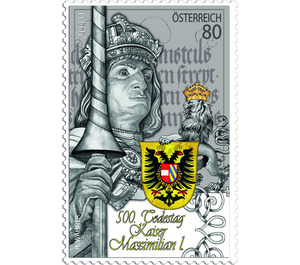500th anniversary of the death of Emperor Maximilian I - Austria / II. Republic of Austria 2019 - 80 Euro Cent
Theme: Well-known people
| Country | Austria / II. Republic of Austria |
| Issue Date | 2019 |
| Face Value | 80.00 |
| Color | grey white |
| Printing Type | offset |
| Stamp Type | Commemorative |
| Item Type | Stamp |
| SID | 769274 |
| Dimensions | 32.00 x 50.00 |
| In 104 Wishlists | |
Emperor Maximilian I, also know to many as the “last knight”, was one of the most important monarchs of Austria. To commemorate the 500th anniversary of his death, Austrian Post is issuing a commemorative stamp decorated with gold embossing. Maximilian I was born in 1459 in Wiener Neustadt Castle as the son of the Habsburg emperor Friedrich III. From his earliest childhood he was groomed for his future role as ruler. His marriage to Mary of Burgundy in 1477 made him Duke of Burgundy, and in 1508 he became the emperor of the Holy Roman Empire. After his death in 1519, his body was interred in the castle chapel in Wiener Neustadt; the last resting place of the urn containing his heart is in the Church of Our Lady in Bruges, in Mary of Burgundy's sarcophagus. Maximilian married both of his children, Philip the Fair and Margaret, to heirs of the Spanish throne, thus laying the foundation stone for the successful marriage policy of the Habsburgs, which culminated with his grandson Emperor Charles V in an empire in which “the sun never sets”. The last knight: Maximilian’s reign was characterised not only by the countless campaigns and his policy of alliances, but also by his efforts to make the administration of his huge empire more effective. He is considered the founder of the postal service as he was the first to institute a regular courier service between his residence in Innsbruck and the outposts of his empire in places such as Burgundy. Maximilian always consciously strove to ensure that he would be remembered as an illustrious monarch. As an enthusiastic participant in tournaments and the composer of the poetic work “Theuerdank” he styled himself the “last knight” and was a patron of the arts and sciences. Innsbruck owes its Golden Roof to him, the magnificent oriel window decorated with reliefs depicting scenes from his life. The stamp shows the motif from the special coin “Ritterlichkeit” (chivalry) which is to be issued by the Austrian Mint: a portrait of Maximilian with a lance and his coat of arms held by a crowned heraldic lion. The coat of arms with the colours of Austria and Burgundy on the shield is reminiscent of the illustration on the Golden Roof. In the background of the stamp an excerpt from “Theuerdank” can be seen.


